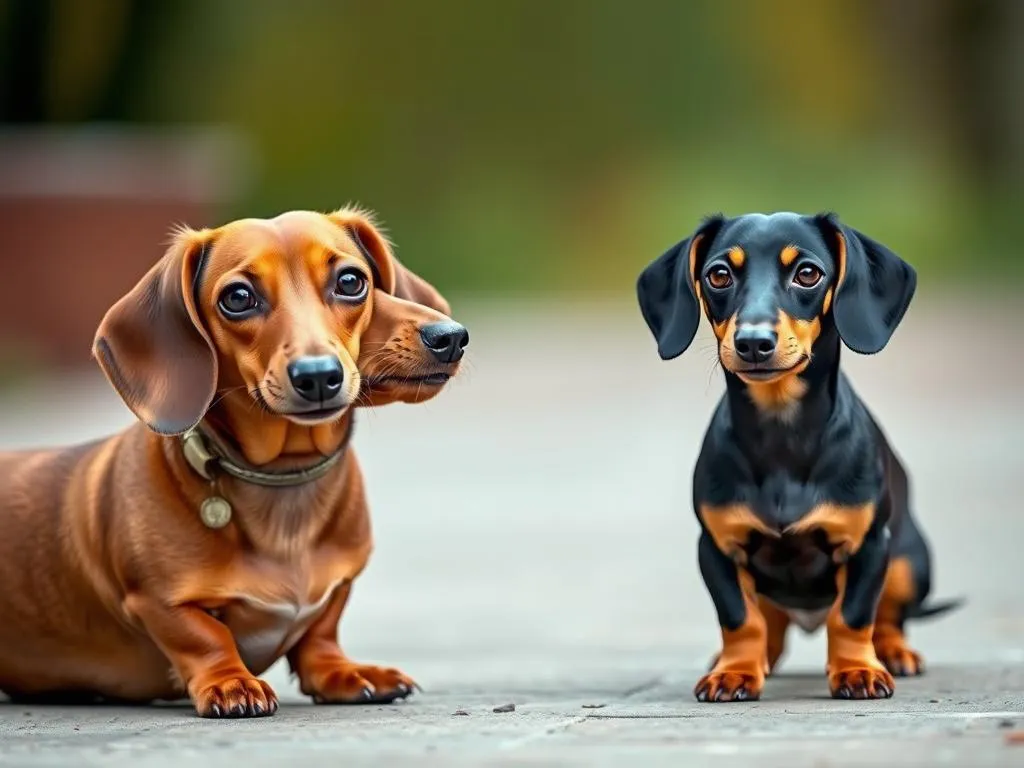
Introduction
Dachshunds are a beloved breed known for their unique appearance and spirited personality. Originally bred in Germany, these dogs have a rich history as hunting companions, specifically for burrowing animals like badgers. Over the years, Dachshunds have gained immense popularity, becoming cherished family pets around the world. Their playful demeanor and loyalty make them a favorite among dog owners.
When considering a Dachshund, potential owners often find themselves deliberating between the standard Dachshund and the Miniature Dachshund. While both share many characteristics, there are distinct differences that can influence your decision. This article aims to compare these two variations, highlighting their similarities, differences, and essential considerations for prospective dog owners.
Understanding Dachshunds
History and Origin
The Dachshund breed dates back to the 15th century in Germany, where they were bred for their keen hunting abilities. Their name means “badger dog” in German, reflecting their original purpose. Over time, their role shifted from hunting to companionship, leading to their popularity as family pets.
Dachshunds come in three coat types: smooth, long-haired, and wire-haired. Each type has its unique set of grooming needs and personality traits, but all Dachshunds share a distinctive elongated body and short legs.
Physical Characteristics
Dachshunds are instantly recognizable with their long bodies and short legs. They have deep chests, elongated snouts, and large, expressive eyes. While the general appearance is consistent across the breed, variations exist in coat types:
- Smooth: Short, shiny fur that requires minimal grooming.
- Long-haired: Soft, flowing fur that needs regular brushing to prevent tangles.
- Wire-haired: Coarse, wiry fur that also requires specific grooming techniques.
Understanding these characteristics is crucial when comparing standard and Miniature Dachshunds.
Dachshund vs Miniature Dachshund: Key Differences
Size and Weight
One of the most noticeable differences between standard and Miniature Dachshunds is their size.
- Standard Dachshund: Typically weighs between 16 to 32 pounds and stands about 8 to 9 inches tall at the shoulder.
- Miniature Dachshund: Weighs up to 11 pounds and stands around 5 to 7 inches tall.
This size difference not only affects their physical appearance but can also influence their behavior and care needs.
Temperament and Behavior
Both standard and Miniature Dachshunds share a lively and affectionate temperament. However, slight differences exist:
-
Standard Dachshunds: They tend to be more independent and can exhibit a stronger hunting instinct. This breed is often more assertive and may require a firmer hand in training.
-
Miniature Dachshunds: Generally more playful and social. They often bond closely with their owners and may be more adaptable to various living conditions.
In terms of energy levels, standard Dachshunds might require more exercise due to their larger size, while Miniature Dachshunds can thrive in smaller spaces with less intense activity.
Health Considerations
Health issues can vary slightly between standard and Miniature Dachshunds.
-
Standard Dachshunds: Prone to obesity, which can lead to back problems, particularly due to their elongated spine. Other common health issues include hip dysplasia and eye disorders.
-
Miniature Dachshunds: Also face similar health concerns, including intervertebral disc disease (IVDD), but their smaller size may reduce the risk of some weight-related issues.
Both breeds typically have a lifespan of 12 to 16 years, making them long-term companions for their owners.
Choosing the Right Dachshund for You
Lifestyle Considerations
When selecting between standard and Miniature Dachshunds, consider your living situation:
-
Standard Dachshunds: They thrive in homes with ample space for activity. A fenced yard is ideal, as they enjoy running and exploring.
-
Miniature Dachshunds: They can adapt well to apartment living, provided they receive daily walks and playtime.
Both breeds require regular exercise, but their activity levels may differ based on size and personality.
Family Compatibility
Family dynamics play a significant role in choosing the right breed.
-
Standard Dachshunds: They are generally good with children but may be less tolerant of rough play. Supervision is necessary during interactions.
-
Miniature Dachshunds: Their playful nature makes them great companions for children. They tend to be more forgiving and can handle a bit of roughhousing.
Both breeds can coexist with other pets, but early socialization is key to ensuring harmonious relationships.
Training and Socialization
Training is crucial for both standard and Miniature Dachshunds, but each may present unique challenges:
-
Standard Dachshunds: They can be stubborn and may require consistent training methods. Positive reinforcement works best to encourage good behavior.
-
Miniature Dachshunds: While they can also be stubborn, they often respond well to socialization and training classes. Early exposure to different environments and people can help mitigate behavioral issues.
Both breeds benefit from early socialization to develop well-rounded personalities.
Grooming and Maintenance
Coat Care
Grooming needs can vary significantly based on coat type:
-
Smooth Coats: Minimal grooming is required, with occasional brushing to remove loose hair.
-
Long-haired Coats: Regular brushing is essential to prevent mats and tangles. Bathing should be done as needed.
-
Wire-haired Coats: Requires regular grooming, including hand-stripping to maintain their texture and appearance.
Health Maintenance
Routine veterinary care is critical for both breeds. Regular check-ups can help catch health issues early.
Nutrition is another important aspect. Both standard and Miniature Dachshunds should be fed high-quality dog food appropriate for their age and size. Portion control is vital, especially for standard Dachshunds, to prevent obesity and related health issues.
Common Myths and Misconceptions
Size Misunderstandings
Many people mistakenly believe that the Miniature Dachshund is simply a smaller version of the standard breed. While size is the most apparent difference, there can also be variations in temperament and energy levels that are not immediately obvious.
Behavior Stereotypes
Dachshunds are often stereotyped as aggressive or overly independent. In reality, both standard and Miniature Dachshunds are affectionate and loyal companions. Their behavior largely depends on training, socialization, and individual personality rather than size alone.
Conclusion
In summary, both the standard and Miniature Dachshund offer unique traits that cater to different lifestyles and preferences. While they share many similarities, their differences in size, temperament, and care requirements can significantly impact your experience as a dog owner.
When choosing between these two delightful breeds, it’s essential to reflect on your living situation, family dynamics, and personal preferences. Both variations can bring joy and companionship into your life, so take the time to find the right fit for you and your family.








